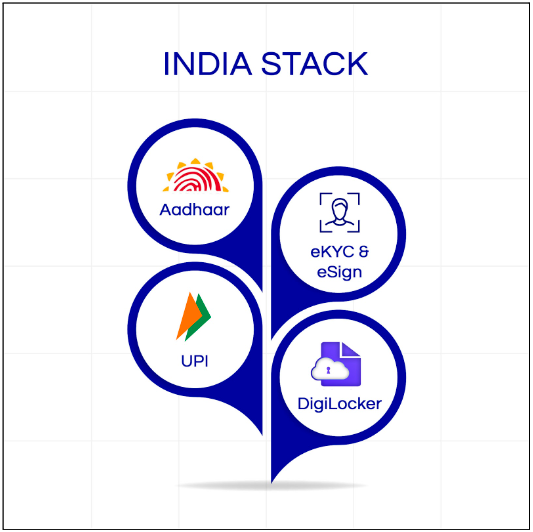What is India Stack & How it helps transform businesses
- Team
- Jul 20, 2023
- 3 min read
Updated: Nov 28, 2023

As we observe the transformative power of the digital era, it is remarkable to witness how rapidly changing technologies drive businesses in our country to adapt and innovate.
The cornerstone of this digital revolution is 'India Stack' - a unique digital infrastructure acting as a catalyst for business transformation. The question must arise what India stack is? And more importantly, how is it impacting the businesses? Let's take a deeper look.
Understanding India Stack
India Stack, a groundbreaking digital infrastructure, comprises a set of Application Programming Interfaces (APIs) that enables governments, businesses, startups, and developers to deliver presence-less, paperless, and cashless services. This transformative framework is built upon four key layers, each playing a distinct yet interlinked role in the system.
Four key layers of India Stack:
Identity Layer - Aadhaar
Paperless Layer - eKYC and eSign
Cashless Layer - Unified Payments Interface (UPI)
Consent Layer - Data Empowerment and Protection Architecture (DEPA)

1. Identity Layer - Aadhaar
Aadhaar, the world's largest biometric ID system, forms the foundational layer of India Stack. Providing unique identification to over a billion Indian residents, Aadhaar enables accurate and secure identity verification. This universally accessible identity platform eliminates the need for multiple identity proofs and ensures seamless, reliable verification, acting as the bedrock upon which the other layers of India Stack function.
2. Paperless Layer - eKYC and eSign
Sitting atop the Aadhaar layer are eKYC (Electronic Know Your Customer) and eSign. eKYC provides a digital process for businesses to verify a customer's identity and address, streamlining onboarding and enhancing compliance. eSign, on the other hand, allows the digital signing of documents using Aadhaar. Together, eKYC and eSign pave the way for a truly paperless system, simplifying transactions and minimizing the need for physical documents.
3. Cashless Layer - Unified Payments Interface (UPI)
The UPI layer of India Stack revolutionizes the way money is exchanged. It allows for real-time, round-the-clock money transfers between any two bank accounts in India, encouraging a move towards a cashless economy. Its interoperability across banks and platforms makes it a game-changer in digital payments, providing ease, speed, and convenience.
4. Consent Layer - Data Empowerment and Protection Architecture (DEPA)
DEPA, the Consent layer of India Stack, empowers users to control how their data is used. It ensures that personal data is shared only after receiving explicit consent from the user, thereby ensuring data privacy and security. DEPA is critical in fostering trust in the digital ecosystem, encouraging more users and businesses to participate.
The vision behind India Stack is to leverage these layers of technology to fundamentally transform how businesses and government services operate, creating a system that is efficient, transparent, and accessible to every citizen.
Role of India Stack in Digital Infrastructure
The digital infrastructure in India has undergone tremendous change over the past decade. The inclusion of India Stack has played a pivotal role in this evolution. It fosters interoperability and facilitates the integration of various services across different platforms. India Stack's innovative APIs propels the integration of different technological solutions into a unified, versatile digital platform.
The adoption of India Stack has proven beneficial for a plethora of businesses, driving tangible improvements across various domains in the following ways:
Operational Efficiency and Cost Reduction
Enhancing Customer Experience through Cashless and Paperless Transactions
Rapid Onboarding with eKYC
Simplified Regulatory Compliance via Standardized KYC Process
1. Operational Efficiency and Cost Reduction
By adopting India Stack, businesses can drastically enhance their operational efficiency. For instance, the eKYC feature reduces the time and cost associated with manual verification processes, leading to more streamlined operations.
2. Enhancing Customer Experience through Cashless and Paperless Transactions
India Stack enables businesses to offer a superior customer experience. The UPI feature ensures easy and fast money transfers, while eSign eliminates cumbersome paperwork, making transactions smooth and hassle-free for customers.
3. Rapid Onboarding with eKYC
eKYC, a key feature of India Stack, allows businesses to onboard customers swiftly. The digitization of the verification process drastically reduces onboarding time, offering a convenient and efficient experience for new customers.
4. Simplified Regulatory Compliance via Standardized KYC Process
India Stack simplifies regulatory compliance for businesses. eKYC standardizes the KYC process, making it easier for businesses to adhere to regulations and minimize the possibility of errors and non-compliance.
For instance, the India Stack APIs have revolutionized the financial sector. Fintech companies leverage these tools to make transactions seamless, offer paperless banking services, and enable instant, hassle-free customer onboarding.
In essence, the adoption of India Stack presents substantial advantages for businesses across various industries, playing a vital role in their comprehensive digital transformation journey. As we move forward, businesses must fully embrace the capabilities of India Stack to stay competitive and relevant in this fast-paced digital age.
.png)



Comments